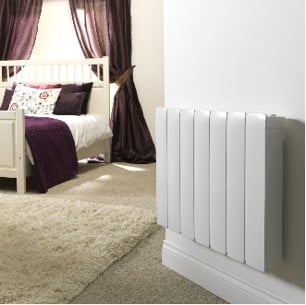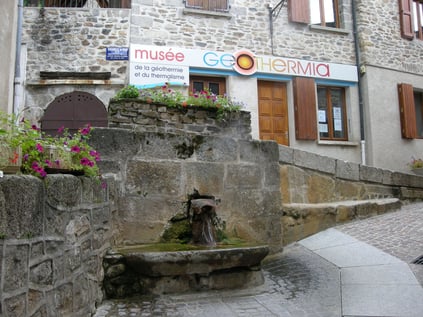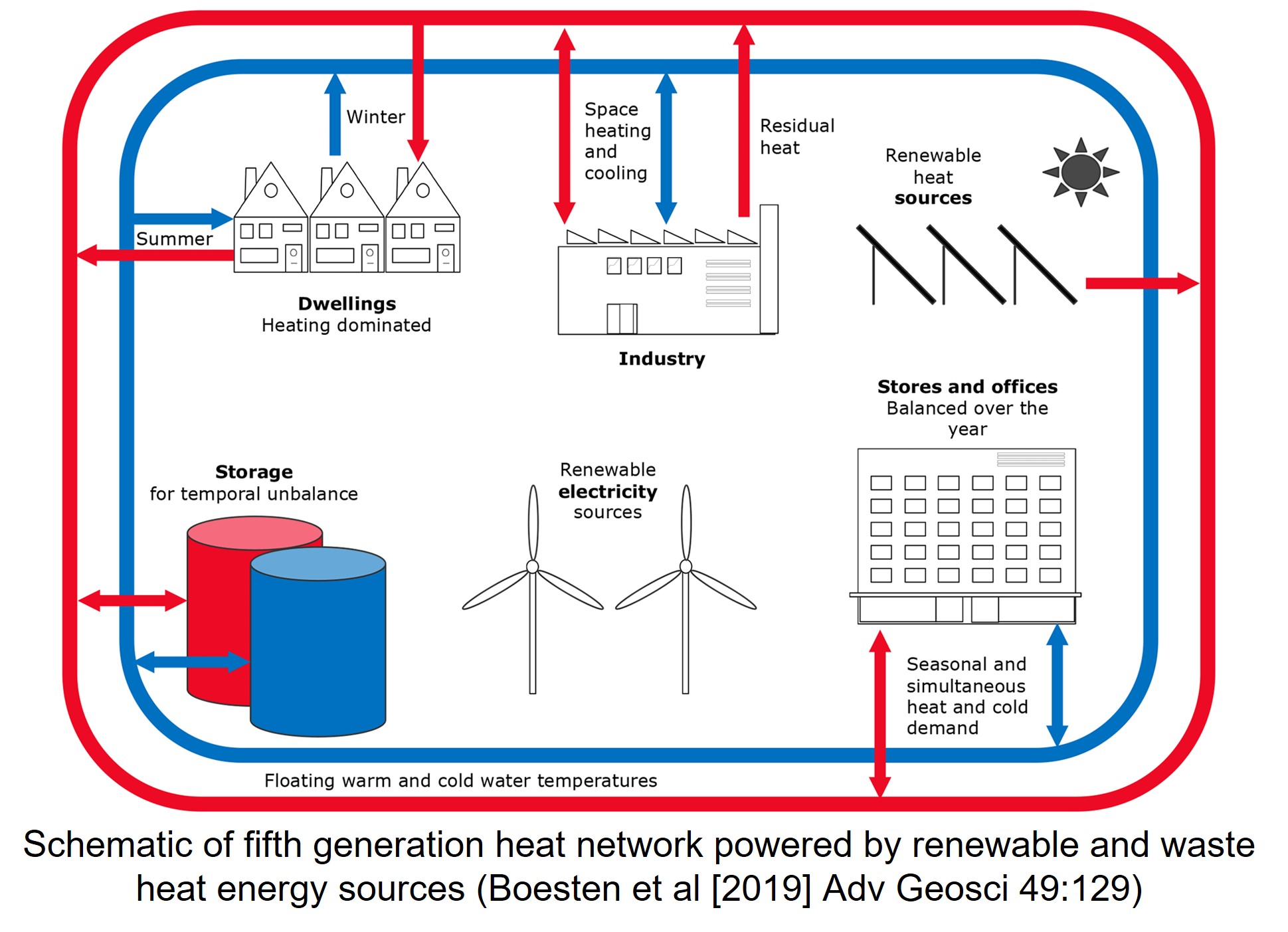
There are many innovations transforming building services driven mainly by the huge challenge of achieving Net Zero targets. In a series of articles, we look at these...
There are many innovations transforming building services driven mainly by the huge challenge of achieving Net Zero targets. In a series of articles, we look at these innovations specifically where they are appropriate for apartment blocks.
Fifth-generation heat network technology uses disseminated energy sources and low flow temperatures, enabling utilisation of multiple waste heat sources and limiting heat energy lost from piping. It may make heat networks efficient enough for some apartment blocks although heat networks need to be regulated to protect consumers.
|
Schematic of fifth generation heat network showing disseminated energy sources and combined heating and cooling functionality (HeatNetNWE) |
This article is the first in a series on recent innovations in building services for apartment blocks:
Apartment innovations 2: heat pumps powering heat networks
Apartment innovations 3: hydrogen in the gas main
Apartment innovations 4: the direct electric option
It was around 700 years ago that someone noticed that the village of Chaudes-Aigues, in the French Massif Central, was below the hot spring it’s named for; Chaudes-Aigues being derived from the Occitan for ‘hot water’. An enterprising engineer channelled the hot water into the village’s homes using wooden pipes, thinking that heated homes would make the winter more bearable. It’s unlikely to have occurred to that engineer that they were inventing the world’s first heat network.
Technology has moved on from mediaeval times but today’s heat networks are based on the same concept that inspired the unknown engineer of Chaudes-Aigues: piped water is used to transfer heat energy from where it is generated to where it is needed. Modern networks may also include a thermal store, which may simply be a tank of temperature-controlled water or may use a solid material with a high thermal capacity which we discussed in more detail in our recent white paper on achieving net-zero carbon emissions.

|
|
Outlet of the River Par in front of the Chaudes-Aigues Geothermal Museum (J-Elle [Wikimedia Commons]) |
![Outlet of the River Par in front of the Chaudes-Aigues Geothermal Museum (J-Elle [Wikimedia Commons])](https://www.atamate.com/hs-fs/hubfs/Apt1_ChaudesAiguesUnlabelled.jpg?width=460&name=Apt1_ChaudesAiguesUnlabelled.jpg) |
|
Outlet of the River Par in front of the Chaudes-Aigues Geothermal Museum (J-Elle [Wikimedia Commons]) |
We have discussed the possible role of heat networks in providing energy-efficient heat for homes in a previous article. This article will focus on the latest innovations in heat network technology, classified as fifth-generation in the CP1 code of practice for heat networks published in 2020 by the Chartered Institute for Building Service Engineers (CIBSE).
A fifth-generation heat network is defined by the following characteristics:
Urban planners often suggest heat networks as ways to utilise economies of scale in providing energy; a single large plant can provide hot water to a lot of homes with less energy than the sum of small plants needed to supply every home. Fifth-generation technology moves away from the dependence on a single large plant and addresses some of the disadvantages that have been identified in heat networks currently in operation.
In a 2021 report, the government’s Climate Change Committee (CCC) warned against ‘lock-in’ in infrastructural development, meaning that infrastructure dependent on technologies that will be difficult to replace with a more carbon-efficient approach later.
Lock-in is likely to be a major problem for existing heat networks, most of which are powered by a central gas-powered plant. As part of the government’s commitment to achieving net-zero carbon emissions by 2050, Britain has been committed to moving away from gas power and the recent gas price shock has underlined the need to do so quickly.
Leaving large numbers of homes dependent on a gas-powered plant is exactly the sort of lock-in that the CCC was talking about.
Fifth-generation networks avoid lock-in by not depending on a single plant. Even if a gas-powered plant provides part of the network’s heat energy, it will be easier to replace it in the future than if it were the sole power source for the network.
A further advantage of disseminated power sources is that they can make full use of waste heat. Some heat networks are powered by high-temperature industrial processes like coal-fired power stations and steel mills. However, few such sources remain in Britain and they are rarely close to residential areas. A further problem is that a heat network dependent on a major industrial plant would be left without a power source if the plant is decommissioned.
|
|
Most available waste heat sources do not provide enough heat to supply the whole network but fifth-generation technology can use multiple sources and use a plant to make up any shortfall.
The GreenSCIES integrated energy system planned for the London Borough of Islington includes a heat network that draws energy from the London Underground and from data centres, which produce a considerable amount of waste heat between them although their outputs are inconsistent and none produces enough energy to power the whole network. GreenSCIES will make up the difference with primary energy sources like photovoltaic cells. Balancing the different sources is more complex than managing a single plant but is well within the capabilities of modern control systems.
GreenSCIES is intended to provide hot water for businesses and homes in Islington and forms part of Islington Council’s plan to achieve net-zero within the borough by 2030.
A major problem with heat networks is that heat energy is lost in transit between the plant and the home. A water pipe inevitably has a high surface area to volume ratio which makes it an efficient conductor of heat. Conduction can be limited by insulating the pipes but it is impossible to prevent completely, and more insulation means pipes take up more space and a higher construction cost.
 |
In a modern well-insulated building, such network losses can contribute significantly to summer overheating, which is already a problem in much of Britain and will become more so as heatwaves become more frequent in the coming decades. The problem is exacerbated by the current UK building regulations, which mandate well-insulated fabric to maximise heating efficiency in winter but have no equivalent requirements for cooling in the summer. Consequently, new buildings require little energy to heat in the winter but many are so prone to overheating that making them comfortable in the summer requires energy-hungry mechanical air conditioning.
Earlier generations of heat network technology supplied water directly to the tap, which Part G of the UK building regulations requires to be stored and circulated at 60°C (140°F) to kill the Legionnaire’s disease bacterium. Fifth-generation technology transfers energy using a heat loop that is not connected to the domestic hot water system but passes through a heat interface unit (HIU) in each flat. The interface unit draws energy from the loop, heating the water inside the flat to the required temperature using a water-source heat pump.
The interface units require an electricity source that is not required for heat networks that provide the water directly, offsetting that energy requirement by avoiding heat losses.
A further advantage of the heat interface unit is that each unit can be metered individually, which enables bills to reflect an individual’s usage. A common complaint among customers on unmetered heat networks is that when everyone is billed equally, people who use less hot water inevitably end up paying for people who use more which leads to bad feeling and disincentivises any attempt to limit usage.
When the pipes for a heat network are installed, they can be combined with pipes that can carry chilled water to cool buildings in the summer, which is often a more energy-efficient approach to cooling than mechanical air conditioning.
Combined heat and cooling networks predate fifth-generation technology. One example is the Olympic Park District Heating and Cooling Network in East London, installed in preparation for the 2012 Olympic Games. However, the fifth generation’s disseminated approach to power sources lends itself to combining the heating and cooling functionalities.
A fifth-generation network is substantially more complex than its predecessors, due partly to the multiple sources of energy input and partly due to the requirement for an interface unit in every home it supplies. Automated control systems can manage the fluctuating inputs and outputs but the complexity still imposes a large installation cost and maintenance requirement.
Installation is complicated by the need for technicians with the skills for every type of energy source as well as the interface units.
A further problem is that a fifth-generation network requires an interface unit in every flat. They are similar in size to a conventional boiler but in retrofitting a fifth-generation network into an apartment block that had previously been powered by a central plant, space would need to be found for a new appliance in every flat.
A further consideration is that high installation costs tend to be reflected by high levels of embodied carbon: the total carbon emitted in the manufacture, installation and ultimate disposal of all components of the heat network across its lifetime. As the installation cost needs to be considered against the possible savings against other heating solutions, so the embodied carbon needs to be considered in the total carbon budget.
Once the network is installed, the mechanical and engineering complexity leads to a significant maintenance burden. For example, GreenSCIES will depend on cascading heat pumps, some of which harvest waste heat and feed it into the network to be piped to heat pumps in the interface units. All of those pumps will require regular preventative maintenance and the provider will need to be able to respond quickly if a unit breaks down.
While a failure of one of the energy sources will not be as catastrophic as a breakdown in a plant that is the sole energy source for a network, the failure of an interface unit will cut a home off from the network so any provider must be ready to respond quickly.
However good the technology of a heat network, it is always going to depend on people wanting to live in homes connected to it. Consumer acceptance of heat networks has never been universal in Britain and there is no point in connecting a block to a heat network if it is going to put people off living in the flats.
Part of the problem is that once a flat is connected to a heat network, the occupier forfeits their ability to change their energy provider and becomes dependent on the pricing and maintenance standards offered by the network’s management. The lack of choice isn’t always detrimental as few people perform regular market comparisons or, as a respondent to a 2015 Which? report on heat networks put it, “at least I don’t have to sit there looking at meerkats”.
The same report found considerable variation in both the pricing and customer experience of different networks. Some networks offered far cheaper heating and hot water than could be achieved in any other way while others offered some of the most expensive on the market. Some customers gave little thought to the fact that their hot water was supplied by a network while others reported the supply of hot water to the tap was unreliable and there was no single point of contact to get maintenance problems resolved.
The dissatisfied customers had little recourse because heat networks fall through a gap in the UK energy regulations. A heat network provider is classified as an energy generator, meaning that they are regulated [PDF] by the Office for Product Safety & Standards (OPSS) in the same way as an electricity or gas supplier. The regulations are written for a situation in which a dissatisfied customer can simply change their supplier, which is straightforward for gas and electricity customers but not an option for a heat network customer.
Most heat network providers are members of the Heat Trust, which describes itself as an independent consumer champion that recognises the Energy Ombudsman as the arbiter of consumer complaints. However, if a provider does not abide by an Ombudsman decision, the Heat Trust’s only sanction is expulsion from the Heat Trust, which is no help to a dissatisfied consumer.
In 2017, the government’s Competition and Markets Authority (CMA) published a study on heat networks that echoed many of the Which? report’s findings and recommendations. The CMA recognised that connecting a home to a heat network makes the occupier dependent on an unregulated monopoly for all the hot water entering their home. Their suggested solution was to transfer responsibility for heat network regulations from the OPSS to the energy regulator, Ofgem, along with the powers needed to protect customers.
At the time of writing, the pricing and service standards of heat networks remain unregulated.
We regard heat networks as one of many potential approaches that should be considered for any development. Fifth-generation technology may make heat networks cost-effective in developments where higher flow temperatures or depdendence ona single plant ruled out earlier systems. However, installation of any heat network is a major expense and should be dependent on a realistic projection of lifetime financial costs and carbon emissions.
They are most likely to be useful where there is a readily available source of waste heat near a residential area with a high demand for hot water and as the GreenSCIES example shows, fifth-generation technology is likely to expand the potential for using waste sources because it can utilise multiple heat sources and supplement it with primary heat production if required.
 |
| Installing an underfloor heating system (Shutterstock) |
Another consideration is that in a building constructed to modern insulation standards, the most efficient approach to space heating is likely to be electric and hot water is only required for taps and showers. The relatively low demand for hot water would rarely justify the complex infrastructure of a heat network although, in a building insulated to modern standards, the low flow temperature makes fifth-generation technology more suitable than earlier heat network technologies.
Older buildings are more likely to depend on ‘wet’ heating systems and have a much higher demand for hot water, and installing a heat network may be an affordable and practical alternative to a programme of refurbishment or replacement. The pipework used by fifth-generation networks may be easier to retrofit than earlier generations that require bulky insulation but space will still need to be found for the interface units.
The single biggest problem with heat networks remains the lack of consumer protection, which disincentivises potential customers from moving into networked flats even if the network is the most technically appropriate solution for a given development. Atamate supports the CMA’s position that heat networks should be regulated by Ofgem.
However, our view is that even if the regulatory problems can be resolved, the technical complexities inherent to avoiding overheating are likely to limit the application of heat networks. As with any other technology, a fifth-generation heat network should be compared against other options for any development and we expect that it is a rare set of circumstances that will position even the fifth-generation network as the best option.
If you’d like to know more about how the atBOS platform can enhance the energy performance of apartment blocks or any other type of building, ask us on the form and we'll be happy to discuss it.
Or, download our latest Whitepaper on achieving Net Zero in Buildings - 

There are many innovations transforming building services driven mainly by the huge challenge of achieving Net Zero targets. In a series of articles, we look at these...

There are many innovations transforming building services driven mainly by the huge challenge of achieving Net Zero targets. In a series of articles, we look at these...